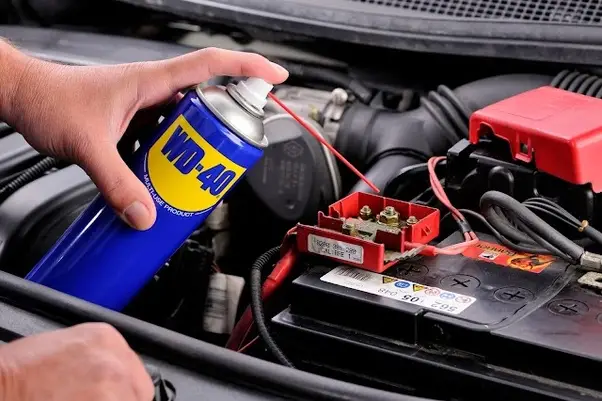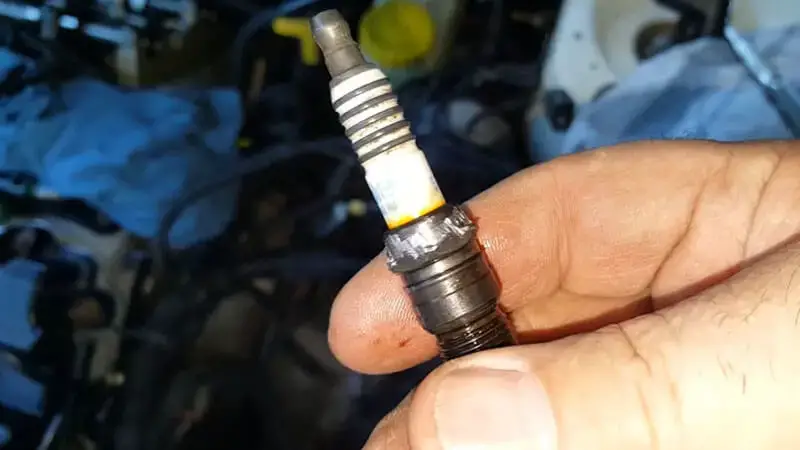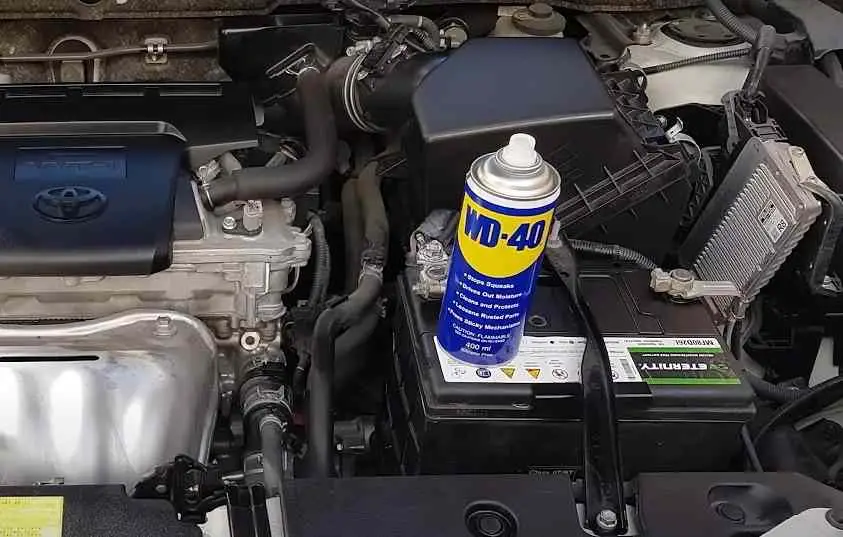Yes, you can spray WD40 in spark plug holes with maintaining proper caution. Generally, WD-40 acts as a protective barrier against moisture, preventing rust buildup within the spark plug hole. It can also function as a lubricant, to loosen stuck spark plugs. It’s important to be aware of misfires, potential engine damage, and loosening spark plugs when using WD40.
Many people get confused about using WD40 and ask if they can spray wd40 in a spark plug hole. So, there is a lot to know when using wd40 in a spark plug hole. Go through this whole article to gain knowledge about using WD40.
Key Takeaways
- WD-40 can be used cautiously in spark plug holes for protection against moisture and to loosen stuck spark plugs.
- Safe alternatives to WD-40 for spark plug hole cleaning include carburetor cleaner, oil, air guns, and brake cleaner.
- To clean spark plug holes properly, locate and extract the spark plugs and examine their condition.
- Wearing protective eyewear and gloves, working in a well-ventilated area is necessary when working with WD40.
What Could Happen If You Spray WD40 in Spark Plug Hole?
WD-40 is the ideal spray for spark plug holes. It can serve some beneficial purposes when lubricating spark plug holes. You can also use it to loosen stuck spark plugs.
However, it’s necessary to exercise caution and be aware of the potential negative outcomes of WD-40. It generally includes misfires, damage to the engine, loosening of the spark plug, and residue buildup over time.

In general, WD-40 should be used in accordance with the manufacturer’s recommendations or the advice of a qualified mechanic. It’s not a replacement for proper maintenance and should not be used as a cleaner for spark plug holes.
Also, you shouldn’t use it as a substitute for other specialized products when needed.
How to Clean Spark Plug Hole Properly with WD-40
To clean the spark plug hole properly it is important to follow these steps properly. But before that, you’ll need some tools such as-
- Mechanical Gloves or any thick gloves
- T bar/wrench/spanner
- Pliers
- WD-40
- Toothbrush
- Microfiber cloth
So let’s have an overview of these steps.
Step 1: Locating Spark Plugs & Extracting
- Ensure the engine is completely cool before starting.
- Remove the engine compartment cover to access the spark plugs.
- Brush away loose dirt and debris to prevent them from falling into the spark plug holes or combustion chamber.
- Open the bolts of the combustion chamber using a wrench.
- Remove the ignition coils from the cylinders.
- Using pliers, loosen and extract the spark plugs using a socket wrench with an extension bar.

Step 2: Reading Spark Plugs Properly
- Examine the condition of the spark plugs to gain insights into your engine’s performance.
- A worn central electrode may require replacement.
- A dry, black sooty appearance on the central electrode may indicate fuel leakage.
- Slight discoloration without deposits is usually normal.
- Dry and sandy deposits on the outer electrode may indicate valve seal issues and oil getting into the cylinder.
- Wet gunk deposits can signal the need for thorough engine inspection.
Step 3: Cleaning with WD-40
- WD-40 is recommended for cleaning spark plugs.
- Spray WD-40 on a microfiber cloth and rub it over the spark plug.
- Alternatively, you can spray WD-40 directly on the spark plug and wipe it clean with a soft cloth.
- After cleaning, reinstall the spark plugs and start the engine to observe any improvements.
What to Spray in Spark Plug Hole Except WD40
These sprays are safe and effective options for cleaning spark plug holes. Here’s an overview of their uses:
Carburetor Cleaner:
A stronger option compared to WD-40, carburetor cleaner is effective at breaking down hardened deposits in spark plug holes.
It is safe to use in spark plug holes because it dissolves various types of debris and unwanted materials.
Oil:
A small amount of oil can be used as a lubricant for removing stubborn or rusted spark plugs. However, use it properly to avoid making the spark plug too loose.
However, the centrifugal clutch is also a sensitive part. So, you need to know how to identify whether your centrifugal clutch is bad.
Air Gun:
An air gun, when properly inserted into the spark plug hole, can blow away excess gunk, and loose materials. It’s particularly useful after using cleaners like WD-40 or carburetor cleaner to ensure a clean environment.
Compressed air from a can or an air gun is excellent for quickly removing loose dirt from spark plug holes. It’s particularly useful after using a cleaner to ensure a clean surface.

Brake Cleaner:
Brake cleaner is also a safe option for cleaning spark plug holes. A small amount of brake cleaner can dissolve most debris and gunk. Afterward, you can use a clean cloth to wipe away any remaining oil residue or dirt.
It also can be used in combination with a wire brush and Emery cloth to thoroughly clean the area. As always, exercise caution when working with any automotive maintenance chemicals, and try to wear appropriate safety gear.
Prevention Measures That You Need to Follow
These precautions are necessary when working with WD-40 or any similar flammable and potentially irritating product. Safety should always be a top priority. So,
Wear Protective Eyewear:
Protect your eyes from potential irritation by wearing safety goggles or protective eyewear. Avoid spraying WD-40 near your face.
Wear Gloves:
To prevent skin irritation, it’s advisable to wear gloves when handling WD-40. After use, wash your hands thoroughly with soap and water.
Use in a Well-Ventilated Area:
WD-40 can release vapors and aerosols that may be harmful if inhaled. Use the product in a well-ventilated area, or consider wearing a mask to minimize the risk of inhaling fumes.
Keep Away from Heat, Sparks, and Flames:
WD-40 is flammable, so it’s essential to keep it away from potential ignition sources. Generally, these sources are open flames, sparks, or hot surfaces.
Do Not Spray on an Open Flame or Ignition Source:
Never spray WD-40 directly onto an open flame or any ignition source, as it can create a fire hazard.
Following these precautions will help ensure your safety while using WD-40 for spark plug maintenance or any other application. However, If you are interested in Carter’s go-kart, it can be enjoyable to know Carter’s go-kart identification.
Frequently Asked Questions (FAQs):
Can You Put Oil in Spark Plug Hole?
Yes, introducing a small quantity of oil into a spark plug hole can aid in improving compression results. Initially, you test the compression and add a small amount of oil to a spark plug hole. Then assess if it enhances compression or not.
What Causes Spark Plug to Leak?
Spark plug leaks are typically caused by failed O-rings or spark plug tube seals. These components serve to keep your spark plugs dry by preventing the entry of engine oil and coolant.
Can Fuel Damage Spark Plugs?
Yes, fuel contamination can potentially damage spark plugs. When contaminated fuel mixes with air in the engine, it can create a lean air-to-fuel ratio. This lean condition can lead to higher operating temperatures.
How Tight Should Spark Plugs Be?
You should give the spark plug an additional ½ to ⅔ turn using a spark plug wrench. You should tighten spark plugs by turning them finger-tight until the gasket contacts the cylinder head. If it’s a taper seat spark plug, turn it about 1/16 more after it contacts the cylinder head.
What Happens If Spark Plug Is Not Tight?
If you don’t tighten the spark plugs sufficiently, they won’t seat properly in the cylinder head. This can reduce heat dissipation during the ignition cycle. Potentially it can cause overheating in the plug and lead to significant engine malfunctions.
Conclusion
Now it is clear if you can spray wd40 in a spark plug hole or not.
WD-40 acts as a protective barrier against moisture, preventing rust buildup within the spark plug hole. Remember to always maintain safety precautions, wear appropriate protective gear, and consult a mechanic.
